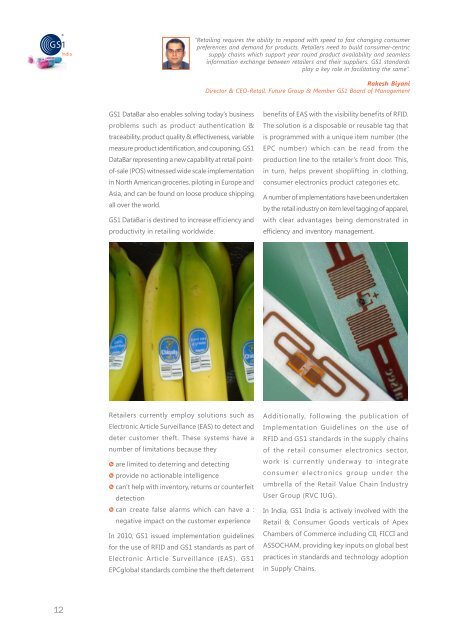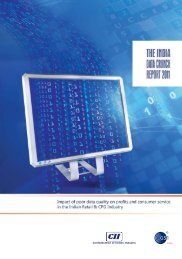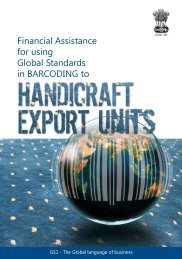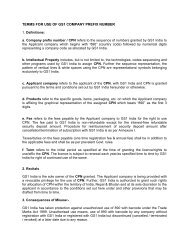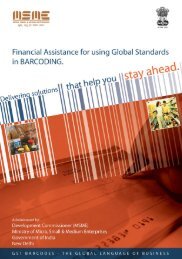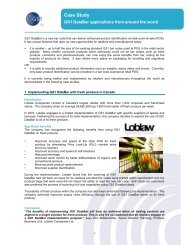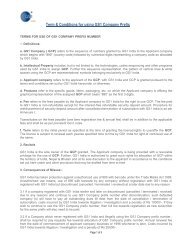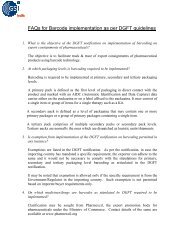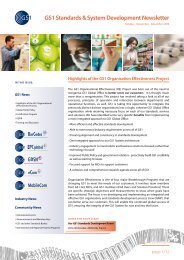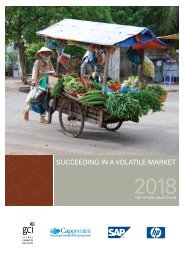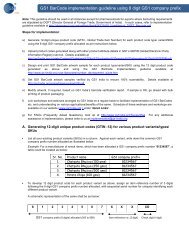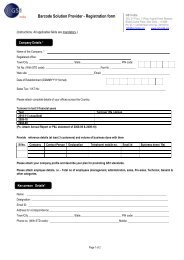Annual Report 2010-11 - GS1 India
Annual Report 2010-11 - GS1 India
Annual Report 2010-11 - GS1 India
Create successful ePaper yourself
Turn your PDF publications into a flip-book with our unique Google optimized e-Paper software.
“Retailing requires the ability to respond with speed to fast changing consumer<br />
preferences and demand for products. Retailers need to build consumer-centric<br />
supply chains which support year round product availability and seamless<br />
information exchange between retailers and their suppliers. <strong>GS1</strong> standards<br />
play a key role in facilitating the same”.<br />
Rakesh Biyani<br />
Director & CEO-Retail, Future Group & Member <strong>GS1</strong> Board of Management<br />
<strong>GS1</strong> DataBar also enables solving today’s business<br />
problems such as product authentication &<br />
traceability, product quality & effectiveness, variable<br />
measure product identification, and couponing. <strong>GS1</strong><br />
DataBar representing a new capability at retail pointof-sale<br />
(POS) witnessed wide scale implementation<br />
in North American groceries, piloting in Europe and<br />
Asia, and can be found on loose produce shipping<br />
all over the world.<br />
<strong>GS1</strong> DataBar is destined to increase efficiency and<br />
productivity in retailing worldwide.<br />
benefits of EAS with the visibility benefits of RFID.<br />
The solution is a disposable or reusable tag that<br />
is programmed with a unique item number (the<br />
EPC number) which can be read from the<br />
production line to the retailer’s front door. This,<br />
in turn, helps prevent shoplifting in clothing,<br />
consumer electronics product categories etc.<br />
A number of implementations have been undertaken<br />
by the retail industry on item level tagging of apparel,<br />
with clear advantages being demonstrated in<br />
efficiency and inventory management.<br />
Retailers currently employ solutions such as<br />
Electronic Article Surveillance (EAS) to detect and<br />
deter customer theft. These systems have a<br />
number of limitations because they<br />
y are limited to deterring and detecting<br />
y provide no actionable intelligence<br />
y can’t help with inventory, returns or counterfeit<br />
detection<br />
y can create false alarms which can have a :<br />
negative impact on the customer experience<br />
In <strong>2010</strong>, <strong>GS1</strong> issued implementation guidelines<br />
for the use of RFID and <strong>GS1</strong> standards as part of<br />
Electronic Article Surveillance (EAS). <strong>GS1</strong><br />
EPCglobal standards combine the theft deterrent<br />
Additionally, following the publication of<br />
Implementation Guidelines on the use of<br />
RFID and <strong>GS1</strong> standards in the supply chains<br />
of the retail consumer electronics sector,<br />
work is currently underway to integrate<br />
consumer electronics group under the<br />
umbrella of the Retail Value Chain Industry<br />
User Group (RVC IUG).<br />
In <strong>India</strong>, <strong>GS1</strong> <strong>India</strong> is actively involved with the<br />
Retail & Consumer Goods verticals of Apex<br />
Chambers of Commerce including CII, FICCI and<br />
ASSOCHAM, providing key inputs on global best<br />
practices in standards and technology adoption<br />
in Supply Chains.<br />
12


